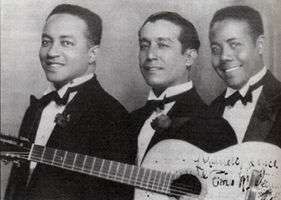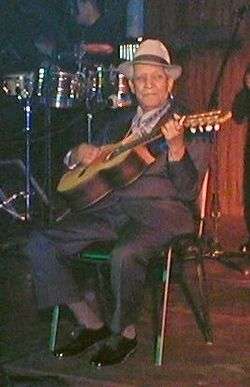Lágrimas negras (song)
"Lágrimas negras" (Spanish for Black Tears) is a bolero-son by Miguel Matamoros, first recorded by the Trío Matamoros in 1931. The song was written in Santo Domingo, Dominican Republic, in 1930, when Matamoros was on his way back to Cuba from the Ibero-American Exposition of 1929.[1] The song has been described as the "perfect fusion of the son with the bolero".[2] It became the Trío Matamoros' most famous song, along with "Son de la loma".
Recordings

Trío Matamoros, around 1930. They recorded the first known version.

Compay Segundo
- Trío Matamoros
- Adalberto Álvarez
- Azul Azul
- Rubén Blades
- Compay Segundo (also in duo with Cesária Évora)
- Celia Cruz
- Dan Den
- Barbarito Díez
- José Feliciano
- Olga Guillot
- Orquesta Aragón
- Omara Portuondo
- María Dolores Pradera (also in with Cachao and Diego el Cigala)
- Rachael Price
- Adalberto Santiago
- Los Tres
- Bebo Valdés, Cachao and Carlos "Patato" Valdés: El Arte del Sabor
- Bebo Valdés & Diego el Cigala with Paquito D'Rivera: Lágrimas negras
- Chucho Valdés and Irakere
- Cuco Valoy
- María Teresa Vera
- Vieja Trova Santiaguera
gollark: Technically Android ROMs aren't *actually* on read-only memory, or updates wouldn't work, they're just not user-writable under normal conditions.
gollark: It specifically doesn't have a partition *named* `system`, which I believe is required.
gollark: Honestly, I have no idea, and I don't have good enough access to actually check.
gollark: I suspect it's doing something incomprehensible and eldritch, or at least not standard-compliant.
gollark: At this point I have no idea how its stock ROM manages to actually boot since it appears to somehow not have a system partition.
References
- Nacido en Cuba: música cubana (in Spanish). Editorial Ceiba. 1999. p. 96.
- Sublette, Ned (2007). Cuba and Its Music: From the First Drums to the Mambo. Chicago Review Press. p. 368. ISBN 978-1-56976-420-6.
External links
This article is issued from Wikipedia. The text is licensed under Creative Commons - Attribution - Sharealike. Additional terms may apply for the media files.